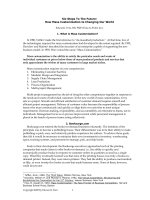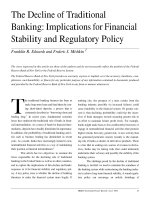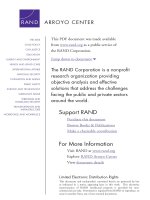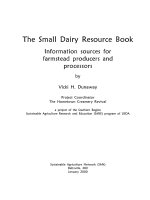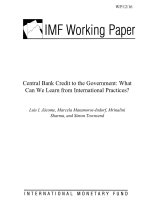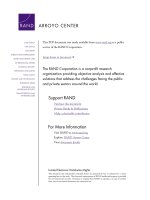Looking to the Future - What Does Transformation Mean for Military Manpower and Personnel Policy pdf
Bạn đang xem bản rút gọn của tài liệu. Xem và tải ngay bản đầy đủ của tài liệu tại đây (282.02 KB, 52 trang )
CHILDREN AND ADOLESCENTS
CIVIL JUSTICE
This PDF document was made available from www.rand.org as a public
service of the RAND Corporation.
EDUCATION
ENERGY AND ENVIRONMENT
HEALTH AND HEALTH CARE
Jump down to document6
INTERNATIONAL AFFAIRS
POPULATION AND AGING
PUBLIC SAFETY
SCIENCE AND TECHNOLOGY
SUBSTANCE ABUSE
TERRORISM AND
HOMELAND SECURITY
The RAND Corporation is a nonprofit research
organization providing objective analysis and effective
solutions that address the challenges facing the public
and private sectors around the world.
TRANSPORTATION AND
INFRASTRUCTURE
U.S. NATIONAL SECURITY
Support RAND
Purchase this document
Browse Books & Publications
Make a charitable contribution
For More Information
Visit RAND at www.rand.org
Explore the RAND National Security Research Division
View document details
Limited Electronic Distribution Rights
This document and trademark(s) contained herein are protected by law as indicated in a notice
appearing later in this work.
This product is part of the RAND Corporation occasional paper series. RAND
occasional papers may include an informed perspective on a timely policy issue, a
discussion of new research methodologies, essays, a paper presented at a conference, a
conference summary, or a summary of work in progress. All RAND occasional papers
undergo rigorous peer review to ensure that they meet high standards for research
quality and objectivity.
Looking to the Future
What Does Transformation
Mean for Military Manpower
and Personnel Policy?
BETH ASCH, JAMES R. HOSEK
OP-108-OSD
June 2004
Prepared for the Office of the Secretary of Defense
The research described in this report was sponsored by the Office of the Secretary of Defense
(OSD). The research was conducted in the RAND National Defense Research Institute, a
federally funded research and development center supported by the OSD, the Joint Staff, the
unified commands, and the defense agencies under Contract DASW01-01-C-0004.
ISBN 0-8330-3587-8
The RAND Corporation is a nonprofit research organization providing objective analysis
and effective solutions that address the challenges facing the public and private sectors
around the world. RAND’s publications do not necessarily reflect the opinions of its research
clients and sponsors.
R® is a registered trademark.
© Copyright 2004 RAND Corporation
All rights reserved. No part of this paper may be reproduced in any form by any electronic or
mechanical means (including photocopying, recording, or information storage and retrieval)
without permission in writing from RAND.
Published 2004 by the RAND Corporation
1700 Main Street, P.O. Box 2138, Santa Monica, CA 90407-2138
1200 South Hayes Street, Arlington, VA 22202-5050
201 North Craig Street, Suite 202, Pittsburgh, PA 15213-1516
RAND URL: />To order RAND documents or to obtain additional information, contact
Distribution Services: Telephone: (310) 451-7002;
Fax: (310) 451-6915; Email:
Preface
This paper concerns the relationship between the military transformation now under way
and the manpower and personnel policies that are needed to support a transforming force. It
was prepared for the Conference on the All-Volunteer Force After 30 Years, held in Washington, D.C., on September 16–17, 2003, and should be of interest to the defense manpower policy community. The paper and the research that underlies it are part of a larger
RAND Corporation project on the flexibility of military compensation, which is sponsored
by the Office of Compensation, Office of the Under Secretary of Defense for Personnel and
Readiness. The work was conducted within the Forces and Resources Policy Center of the
RAND National Defense Research Institute, a federally funded research and development
center sponsored by the Office of the Secretary of Defense, the Joint Chiefs of Staff, the
unified commands, and the defense agencies.
iii
The RAND Corporation Quality Assurance Process
Peer review is an integral part of all RAND research projects. Prior to publication, this
document, as with all documents in the RAND occasional paper series, was subject to a
quality assurance process to ensure that the research meets several standards, including the
following: The problem is well formulated; the research approach is well designed and well
executed; the data and assumptions are sound; the findings are useful and advance knowledge; the implications and recommendations follow logically from the findings and are explained thoroughly; the documentation is accurate, understandable, cogent, and temperate in
tone; the research demonstrates understanding of related previous studies; and the research is
relevant, objective, independent, and balanced. Peer review is conducted by research professionals who were not members of the project team.
RAND routinely reviews and refines its quality assurance process and also conducts
periodic external and internal reviews of the quality of its body of work. For additional details regarding the RAND quality assurance process, visit />
v
Contents
Preface................................................................. iii
Contents ............................................................... vii
Figures and Tables ........................................................ ix
Acknowledgments......................................................... xi
Introduction .............................................................1
What Is Meant by “Transformation”? ...........................................2
What Are the Implications of Transformation for Military Manpower Requirements?.........4
A Shift from Threat-Based to Capabilities-Based Planning .............................4
Implications for Manpower Requirements and Personnel Management ....................5
Are the Current Personnel Management and Compensation Systems Adequate? ............9
Flexibility of the Current Compensation and Personnel Systems ........................10
Attractive Features of the Current Systems........................................17
Transforming Military Compensation and Personnel Policy ..........................20
The Case for Change ......................................................20
Obstacles to Compensation Reform: The Example of Military Retirement Benefits ...........21
The Demand for Flexibility: An Example ........................................23
Approaches for Change .....................................................24
Performance Appraisals ...................................................25
Awards ..............................................................26
Choice of Duty and Job Assignment..........................................26
Pay for Performance .....................................................28
Conclusion .............................................................30
Appendix: Transformation Defined............................................33
References ..............................................................37
vii
Figures and Tables
Figures
1.
2.
3.
4.
Average Total Enlisted Pay by Service and Year of Service, 1999 ..................12
Average Total Officer Pay by Service and Year of Service, 1999 ...................12
Standard Deviation of Enlisted Pay by Year of Service, Air Force, 1999 .............13
Standard Deviation of Officer Pay by Year of Service, Air Force, 1999 ..............13
Tables
1. Average Amounts of Enlisted Pay, 1999 ...................................11
2. Average Amounts of Officer Pay, 1999 ....................................11
3. Enlisted Year of Service Distribution by One-Digit DoD Occupational Code,
FY 1999 .........................................................15
4. Officer Year of Service Distribution by One-Digit DoD Occupational Code,
FY 1999 .........................................................16
ix
Acknowledgments
The authors thank RAND colleagues Jennifer Kavanagh for a review of the concept of military transformation, Bogdan Savych for a review of the management and economics literature on organizational culture, and C. Christine Fair for a review of the literature on military
culture. We also benefited from comments received at the conference and from reviews provided by James Dertouzos at RAND and by John White at Harvard University’s John F.
Kennedy School of Government.
xi
Introduction
Each decade of the All-Volunteer Force (AVF) has brought new challenges in meeting military manpower supply requirements—challenges that have been successfully met by the Department of Defense (DoD) and Congress. During the 1970s, the initial challenge was to
transition from a conscripted to a volunteer force; meeting that challenge involved an unprecedented increase in military pay. The 1980s involved sustaining the volunteer force with
another large increase in military pay, made necessary because military pay had been allowed
to fall during the late 1970s, and expanding recruiting and retention resources such as bonuses and educational benefits. This period was also notable in that management of the recruiting effort became more sophisticated in describing local markets, motivating recruiters,
and developing effective advertising programs, thereby promoting high-quality personnel at
acceptable costs. The third decade, the 1990s, saw the end of the Cold War, the rise in operations other than war, and an unusually robust civilian economy that again challenged
DoD’s ability to recruit and retain high-quality personnel. This challenge was successfully
met with another substantial increase in military pay that helped restore it to pre-boom levels
relative to civilian pay, a restructuring of pay that gave larger increases to personnel who
reached promotion faster, and increased recruiting and retention resources. The AVF is now
at the beginning of its fourth decade. Although the future is unknown, DoD is transforming
itself to ensure that it is prepared to meet possible future threats. Such transformation requires a reassessment of both the military’s current manpower and personnel policies and the
factors that will affect the continued success of the AVF over the next decade and beyond.
This paper provides input to that reassessment. We begin with a description of how
transformation is defined in the military, drawn from statements and testimony of DoD
leaders and documents such as the 2001 Quadrennial Defense Review. We then discuss the
likely implications of transformation for military manpower requirements. Given the likely
changes in military manpower goals, we then ask whether the existing military personnel
management and compensation systems support those transformation-related goals. Finally,
we discuss the types of personnel management and compensation policy changes that might
be required.
1
What Is Meant by “Transformation”?
The purpose of the military’s transformation effort is to ensure that it has the capabilities it
needs to defend the United States against a spectrum of unknown and uncertain threats.
Transformation is not a one-dimensional concept or a predetermined recipe for change. Instead it is commitment to innovative approaches to war fighting and the support of war
fighters.1
The 2001 Quadrennial Defense Review (QDR) outlined a new defense strategy that
relies on transformation for its success. That strategy represents a shift from one that focused
on specific threats and planning for two major, simultaneous wars to one focused on what
the threats might be and developing capabilities to deter and defend against them. The QDR
identified six major goals:
• Protect the U.S. homeland and bases overseas and defeat weapons of mass destruction
and their means of delivery.
• Project and sustain power in distant environments.
• Deny sanctuary to our enemies by developing capabilities for persistent surveillance,
tracking, and rapid engagement.
• Protect our information networks from attack.
• Use information technology to link different U.S. forces.
• Maintain unhindered access to space and protect space capabilities from enemy attack.
Achieving these goals will require transformational intellectual, cultural, and technological changes not only within the armed forces but within DoD as well. Defense Secretary
Donald Rumsfeld has stated that transformation calls for a revolution in culture in terms of
“the way we think, the way we train, the way we exercise, and the way we fight.” Transformation must “encourage a culture of creativity and intelligent risk taking” and “promote a
more entrepreneurial approach to developing military capabilities.” As described by Chairman of the Joint Chiefs of Staff, General Richard Myers, intellectual change means that people must have “the mental agility to match their capabilities to new and unprecedented missions,” and cultural change means that they must develop an “attitude that values educated
risk-taking and cooperation that spans organizations” (Harper, 2003). Moreover, transformation requires change in doctrine, organization, training, and logistics, bolstered by change in
technology.
____________
1 The
appendix provides a more detailed discussion of the definition of transformation and contains complete citations for
the Rumsfeld, Myers, and McCarthy quotes appearing below.
2
What Does Transformation Mean for Military Manpower and Personnel Policy?
3
Although the definition of transformation is not tied to particular initiatives, several
specific reforms have been defined as vital for future war fighting. These reforms relate to
jointness in military planning and operations, improved personnel management and compensation, and improved acquisition and use of technology.
At its extreme, jointness means the full integration of the different service divisions,
i.e., where capabilities are “born joint.” According to General James P. McCarthy (U.S. Air
Force, Ret.), this integration would be achieved through joint training, the development of
“tailorable” joint force modules, and the creation of a joint command and control capability
to plan missions and conduct operations. Jointness would be far more prevalent, and would
penetrate further into each service, than it has in the past. This concept of jointness seems
consistent with the services each retaining the responsibility and authority to create and sustain specific defense capabilities but engaging jointly in planning the capabilities needed, allocating the capabilities across the services, deciding on battle plans, and tailoring the modules to be deployed (McCarthy, 2001).
A second area of reform is the management and organization of personnel to allow
for greater speed and flexibility in deployment, more decentralized forces that enable subordinate commanders to exploit windows of opportunity, and greater intelligent risk-taking
and innovation.
A third reform required by transformation is improving the use and acquisition of
technology within the fighting forces. Although technology is already a priority, transformation will require that the force be fully connected and networked to ensure that a common
picture of the battlefield is shared. Further, the military must continue to take advantage of
rapidly changing technologies. Although defense officials argue that changing technology is
only one part of transformation, it is clear that dramatic changes in technology are a central
factor in the rationale behind and the progress of transformation.
Transformation is also expected to be an ongoing process, rather than a one-time
change. It is viewed more as a framework for generating and embracing fundamental change
than a process with an endpoint. Thus, it seems likely that the meaning of transformation
itself, and the specific reforms that are pursued, will continue to evolve as the capabilities and
challenges facing the armed forces unfold.
What Are the Implications of Transformation for Military
Manpower Requirements?
A Shift from Threat-Based to Capabilities-Based Planning
A simplified characterization of the manpower requirement determination in the pretransformation era might go as follows. The threats associated with two major theater wars
would be identified in broad terms, e.g., the adversaries, their military capabilities, the types
of battle (air, sea, land), and the geographic locations of battle; from this characterization, the
strategy and battle plans would be devised. These would detail the roles and missions of each
force, the allocation of force “building blocks” to the theaters—e.g., air wings, ships, submarines, Marine expeditionary forces, and Army divisions—and the logistics and manpower
requirements would flow from these roles and missions .
Planning would thus be based on a specific set of threats, and the services would configure the design of their missions, equipment, training, and unit organization to meet those
threats. Their implicit assumption is that by being conservative about the nature of the
threats, they would have sufficient planning and resources to handle smaller operations,
which they think of as lesser-included cases. Given unit organization (e.g., number of personnel by rank and skill) and an estimate of the numbers and types of units needed, manpower requirements would follow.
This simplified version of the planning process belies the many variants of major
theater war, regional conflict, and ancillary missions that were addressed through planning
exercises, field exercises, and investments in the development of doctrine and training. These
activities, and the organizational human capital that accrued as successive generations of
planners and leaders faced a changing national security environment, helped provide assurance that the force—and its manpower—had the capability to meet foreseeable threats on
several fronts.
However, the 2001 QDR shifted the paradigm from a specified set of threats—and
the assumption that if those threats could be met, then so could other threats—to meeting
diverse and uncertain threats through a focus on the development of capabilities. Under
capabilities-based planning, planners must decide upon a threat distribution—the types of
threats and their likelihood of occurrence, singly or simultaneously. For each type of threat,
planners devise robust approaches, i.e., operational plans that can surmount uncertainties as
they arise in the context of the threat. Also, although specific threats are uncertain beforehand, it may be possible to anticipate types of threat and take action to deter or influence
4
What Does Transformation Mean for Military Manpower and Personnel Policy?
5
(“shape”) them. Capabilities-based planning recognizes that because threats are unknowable
beforehand, it is advantageous to be able to select particular capabilities from within each
service and combine them into a joint response. The distinct emphasis on jointness may
mark a new phase of interservice cooperation, although joint planning has occurred for decades and was directly addressed as a priority by the Goldwater-Nichols Reorganization Act of
1986. Advances in sensors, communication, situational awareness, precision-guided munitions, and command-and-control technology now enable ground, air, and sea forces to establish closer working rapport than ever before. This has enlarged the range of maneuver,
increased the size of the supportable front, and permitted rapid and accurate strikes and
counterstrikes, all of which contribute to a greater overall technical capability and to a
growing sense of trust in joint planning and joint operations. Furthermore, technical change
and cultural change (trust) appear to allow the concept of jointness to be implemented at
lower and more decentralized levels of military operations. This enables the services to be
more mutually reliant rather than self-reliant and increases the likelihood that tailored forces,
which select units or parts of units from each service, can be created and placed under joint
command without incurring the resistance and resentment of unit commanders.
Capabilities-based planning is not structured to produce a single estimate of manpower requirements conditional on a prespecified set of threats. Instead, in the new paradigm
it is more productive to think of a relationship between manpower and the probability of
meeting the threats in the threat distribution. For example, at a given level of manpower the
predicted probability of success might be 100 percent for 60 percent of the draws, 90 percent
for 30 percent of the draws, and 80 percent for 10 percent of the draws. Adding capability,
e.g., adding certain types of units and the manpower to man them, increases the predicted
probability of success across the identified range of threats. Capabilities-based planning
therefore provides information about the level of preparedness with respect to that range of
threats and may enable planners to obtain a more precise idea of the trade-offs among adding
different types of units. By not focusing mainly on two major theater wars, capabilities-based
planning is an effective way to assess how to support the strategic goals outlined in the 2001
QDR (mentioned in the previous section of this paper). In the end, this assessment helps
support decisions about weapons investment, roles and missions, organization, and force size.
Planning may take units as preconfigured with respect to their organization, equipment, and personnel, or it may call for the reorganization of existing unit types or the creation of new unit types, as in Army light divisions, Stryker brigades, and Patriot missile units.
Once the number and kind of units required have been designated, manpower requirements
have also largely been designated.
Implications for Manpower Requirements and Personnel Management
As articulated by Secretary Rumsfeld, transformation will require changes throughout the
defense community. Nobody knows exactly what the changes will be, but everybody knows
there will be change in needed capabilities, doctrine, organization, and technology—and
hence in manpower requirements. In the context of compensation and personnel policy,
transformation will require innovative and flexible ways of using personnel, and personnel
can expect to have different kinds of careers. Various studies and commissions have defined
6
What Does Transformation Mean for Military Manpower and Personnel Policy?
what is meant by more flexible use of personnel within the context of the current compensation and personnel management systems. Some of the definitions include the following:
• More variation in the length of the military career, implying careers that extend beyond 30 years and, more controversially, careers that end before 20 years but exceed
10 years.
• Greater emphasis on conserving active duty positions for combat-essential activities—thereby increasing active duty combat and combat support personnel—and
shifting non–combat-essential support to civilian contractors or DoD civilians. OSD
and the services have begun to explore the opportunities for such shifts.
• Continued reliance on the selected reserves in overseas deployments and for manning
domestic positions vacated by deployed active duty personnel, enhanced by development of the “continuum of service” concept whereby qualified reservists may be
called to serve, or volunteer to serve, for a variable number of days in an active assignment.
• Longer time in an assignment for officers and noncommissioned officers (NCOs),
allowing more time to learn a job and to capture the returns to greater job experience. 1 Longer assignments are feasible if longer career lengths are possible, or if average assignment length remains the same but some assignments are shortened while
others are lengthened.
• Fewer moves, i.e., fewer permanent changes of station, which will assist in enabling
longer time in an assignment and should reduce disruption in the lives of military
families.
• More variation in time-in-grade and hence in-grade progression (the timing and
probability of promotion), enabling members to stay in a grade longer rather than
being moved up to a more supervisory grade or forced out by up-or-out constraints
(this is sometimes described as the “up-or-stay” approach).
• Development of multiple career tracks for officers (as the Army has done) and NCOs
to take advantage of gains from specialization and facilitate a better match between
career track and individual skills and preferences. The tracks could have varying time
in grade. For example, those on a leadership track may experience faster grade progression and achieve a higher grade at the end of their career. Those on a more technical track may enter at a higher grade (reflecting more civilian education) but progress more slowly through the grades. 2
This proliferation of ideas and initiatives for greater flexibility in personnel management should contribute both to greater military capability and to increased member satisfaction.
____________
1
As experience in an assignment increases, the service member learns a variety of tasks. More time in an assignment may
mean becoming specialized to the assignment but necessarily more narrow in terms of the breadth of the tasks that can be
done in that assignment.
2 Multiple
career paths could be phased in, affecting only a small fraction of personnel at first and allowing them to choose
to participate or not. This approach would prevent large disruptions to members who expect and prefer the current system.
Depending on the design of a system with multiple career paths, promotion would proceed at the same rate as now, but the
type of positions would be limited to those within a career path.
What Does Transformation Mean for Military Manpower and Personnel Policy?
7
The greater need for flexibility and the call for more innovation and intelligent risktaking will require a changed military culture. That transformed culture will place a premium on adaptability to emergent situations, interoperability and jointness, rapid responsiveness, agility to capitalize on opportunities in the field, and a small logistics footprint.
Culture refers to how things are done within an organization or society; it defines the
tacit rules that influence actions in a wide variety of situations. Culture is rooted in a set of
values, beliefs, rituals, symbols, and assumptions, and it provides a common language and
common knowledge about the norms of behavior.3 By shaping behavior, culture is a strategic
human resource tool that can affect performance and capability. Importantly, culture can act
as a partial substitute for explicit rules of behavior under a range of uncertain circumstances.
To support the goals of transformation, the values and beliefs that define military culture will
have to emphasize innovation and entrepreneurship within the bounds of the military’s
chain-of-command environment, and will recognize the importance of flexibility in managing personnel. Furthermore, jointness and interoperability will be important norms of behavior, and innovative uses of personnel and technology will be defined and rewarded. Leaders will have a particularly important role in communicating these values and rewarding
behavior that conforms to them. Strong leadership and an effective means of disseminating
information about the importance of new values are critical for maintaining a culture that
values innovation and entrepreneurship. Below, we discuss what types of incentives can help
support innovation and cultural change.
Given the far-reaching changes suggested by transformation, a key question is
whether the existing military compensation and personnel systems can accommodate these
changes or whether, in fact, changes in these systems are necessary and important for
achieving the goals of transformation. The current personnel management and compensation
systems have shown an impressive capacity to respond to evolutionary change in the past,
leading to success in attracting and retaining the quantity and quality of personnel required.
As illustrated over the past three decades of the AVF, the personnel and compensation systems have helped to ensure that talented individuals are encouraged to enter and stay in the
military in sufficient numbers; that personnel have the incentive to perform well, to pursue
activities that develop and reveal their capabilities, and to seek positions where those capabilities are put to their best use; and that arduous duties in hazardous conditions and in places
far from home are recognized.
But despite this success, policymakers and analysts have little objective information
on whether personnel and compensation policies have generated a defense workforce that is
equipped to embrace the creativity, risk-taking, and flexibility called for by transformation.
Also lacking is an objective basis for determining whether past policies produced the right
amount of flexibility and risk-taking. Such an objective standard would be valuable for assessing the gains from increases in creativity, risk-taking, and flexibility under transformation. Furthermore, as discussed in the next section, the current military compensation and
personnel system, despite its many successes, seems to hamper rather than promote the flexible use of personnel and to produce remarkably similar personnel outcomes rather than
____________
3 The
importance of corporate culture is recognized in the private sector and has been the subject of numerous management
studies that focus on the definition of culture, the issue of how to measure it, and its effect on a firm’s performance.
8
What Does Transformation Mean for Military Manpower and Personnel Policy?
greater variation in the kinds of military careers called for by transformation. The lack of personnel management flexibility in the current system has been a common theme in recent
studies of the system, including the report of the Defense Science Board Task Force on Human Resources Strategy.
Are the Current Personnel Management and Compensation
Systems Adequate?
Is there any reason to believe that the current systems will not provide the flexibility needed
to support transformation? Does the current military culture incorporate values and norms
that conform to the goals of transformation? We address those questions in this section.
The culture of the U.S. military reflects the military’s historical antecedents: the nature of war fighting in the past, the geography of warfare, the purpose of war fighting (waging war for the nation-state, domestic operations, peacekeeping), and the environment in
which war fighting has occurred. Because these antecedents tend to be service-specific, the
most powerful cultural elements are the service branch subcultures and not the DoD culture.
Various sources argue that the Goldwater-Nichols Act has done little to change the preeminence of service cultures or to form a truly joint culture.1
The service branch subcultures reflect their assigned domain of war on land, sea, and
in the air. As discussed by Builder (1989), several factors are important for defining culture
across the service branches: the identity of the war fighter, the size of the service’s capability,
and the relative importance of technology versus personnel skill in each service. Specifically,
the Air Force sees air power and the role of the pilot as the decisive elements in war. Capability is measured in terms of numbers of wings of bombers or fighters, and technology is a
defining characteristic—with specific platforms, or even airframe models, being intimately
connected with the notion of who the war fighter is, i.e., the pilot. The Navy also relies on
technology, but personnel are more likely to associate themselves with the Navy as an institution, or with a specific community (air, ship, submarine), than with a specific ship or platform. Capability is viewed in terms of command of the high seas and is measured in terms of
the stock of ships. The Army values basic skills in soldiering and war fighting over technology or equipment and often measures capability in terms of end strength, not equipment.
The Marine Corps is often thought to have one of the most distinct cultures, with identity
being most closely tied to being a Marine, rather than being part a specific unit. These subcultures affect the services’ strategic approaches to war and how they conceptualize and prepare for war.
From a personnel standpoint, the military culture has several defining elements, as
discussed by Snider (1999). Discipline is a critical element that helps minimize the confusion
on the battlefield and that, together with ritualization, provides rules on how and when mili____________
1 See
Adolph et al. (1995), Chiarelli (1993), Fautua (2000), and Young and Lovelace (1995). However, other authors argue
that Goldwater-Nichols has had a large effect on the status of jointness, contending that the awareness of the importance of
jointness seems to have increased, as have the Joint Chiefs of Staff (JCS) institutions created to support that objective (see,
for instance, Roman and Tarr, 1998).
9
10
What Does Transformation Mean for Military Manpower and Personnel Policy?
tary personnel can violate the usual social prohibitions on killing and violence. A related element is professionalism, which defines codes of conduct. Cohesion and esprit de corps are elements that address the issue of unit morale and the willingness of unit members to execute
the unit’s mission. From the standpoint of the compensation system, a key element of the
culture is equitable and fair treatment with respect to pay and career opportunities. This feature reflects the common burden of service—regardless of service branch and career
field—and therefore the common expectation of equitable treatment. Furthermore, equitable
treatment with respect to pay and fairly applied personnel policies reflects the value of cohesion as a cultural element and recognizes the divisiveness of unfairly applied compensation
and personnel policies. These cultural elements have given rise to compensation and personnel policies that are well defined, openly applied, and subject to considerable oversight by
DoD and Congress.
Although these policies have been quite successful along many dimensions, they have
elements that are likely to hinder transformation. An important example is the military’s
promotion process, which assesses performance in terms of well-defined criteria. While the
system is an invaluable tool for providing performance incentives, it also arguably gives incentives to members to perform in a predictable manner that conforms to well-defined cultural norms. When there is relatively little variance in performance among promotioneligible members and therefore relatively little variance in individual promotion chances,
each member has an incentive to “play it safe.” Even small mistakes or undesired outcomes
arising from informed risk-taking can have serious consequences in terms of promotion
timing. Frequent rotations exacerbate the climate of “zero tolerance for mistakes” because the
best way to demonstrate high performance when one’s duty tour is short is to follow the path
of one’s predecessor and conform to expectations. The lack of lateral entry and the hierarchical chain of command can also exacerbate the conformity problem because responsiveness to
leadership is a cultural norm, yet those who become leaders in the chain of command
achieved those positions precisely because their performance conformed to expectations. As
the key incentive mechanism for high performance in the military, these pressures for predictable and uniform job behavior embedded in the promotion system are likely to hinder
efforts to foster greater innovation, intelligent risk-taking, and entrepreneurship. In short, the
current military culture, as reflected in the compensation and personnel systems, places a
higher value on predictability and conformity than on flexibility and risk-taking.
Flexibility of the Current Compensation and Personnel Systems
As we will show, the military compensation system leads to highly similar pay by year of
service (YOS) across the branches of service and across occupational areas within a service.
Although this system results in a high degree of equity in compensation—and indeed equity
of opportunity in compensation might be a useful policy in its own right—it is questionable
whether an organization engaged in many different activities and employing many different
technologies should find it efficient to have essentially the same labor-experience mix in each
activity. Numerous special and incentive (S&I) pays exist that can be varied across personnel
and over time, and we find that most of the variation in military cash compensation across
personnel at a given year of service is attributable to variation in special and incentive pays.
S&I pays provide a targeted, efficient way of increasing the level of compensation in response
What Does Transformation Mean for Military Manpower and Personnel Policy?
11
to more arduous or hazardous military duties, higher market wages, or changes in those
wages over the business cycle. But given available information we (and arguably, policy decisionmakers) cannot tell whether special pays are being used to maintain similarity in experience mix and promotion opportunity or to provide the best-suited experience mix for producing output. In fact, the compensation system leads to highly similar retention profiles
across occupational areas.
Cash compensation for military personnel can be divided into regular military compensation,2 S&I pays, bonuses, and miscellaneous allowances and cost of living allowances
(COLAs). 3 Average cash compensation in 1999 was around $32,000 for enlisted personnel
and $65,000 for officers (Tables 1 and 2), and regular military compensation accounted for
over 90 percent of those amounts. S&I pays, such as proficiency pay, career sea pay, parachute duty pay, and hostile fire pay, averaged $300 to $1,350 for enlisted personnel and
$1,000 to $3,000 for officers. These averages may seem low, but the averages are taken over
all personnel and most personnel do not receive any given S&I pay. Also, many S&I pays are
not large. For instance, the average amount of proficiency pay for airmen who received it was
$2,285, but only 3 percent received it. The same was true of bonuses, miscellaneous allowances, and COLAs. For example, the average aviation officer continuation bonus in the Navy
was $12,163, but only 7 percent of Navy officers received it. The average overseas COLA for
soldiers was $1,849, but only 25 percent of soldiers received it.
Table 1
Average Amounts of Enlisted Pay, 1999
Category of Cash Compensation
Regular military compensation (RMC)
Special and incentive pays
Bonuses
Miscellaneous allowances and COLAs
Total
Army
Air Force
Marine Corps
Navy
$30,509
482
372
832
$32,195
$31,398
301
381
1,015
$33,095
$28,241
317
11
785
$29,354
$30,655
1,345
777
967
$33,744
Army
Air Force
Marine Corps
Navy
$61,689
927
673
837
$64,125
$61,599
2,810
1,695
779
$66,883
$58,707
1,889
756
810
$62,162
Table 2
Average Amounts of Officer Pay, 1999
Category of Cash Compensation
Regular military compensation (RMC)
Special and incentive pays
Bonuses
Miscellaneous allowances and COLAs
Total
$59,761
3,134
2,172
872
$65,939
____________
2
Regular military compensation is the sum of basic pay, housing allowance, subsistence allowance, and the federal tax a dvantage owing to the nontaxability of the allowances.
3
This discussion draws on a study by Asch, Hosek, and Martin (2002) for the 9th Quadrennial Review of Military Compensation.

